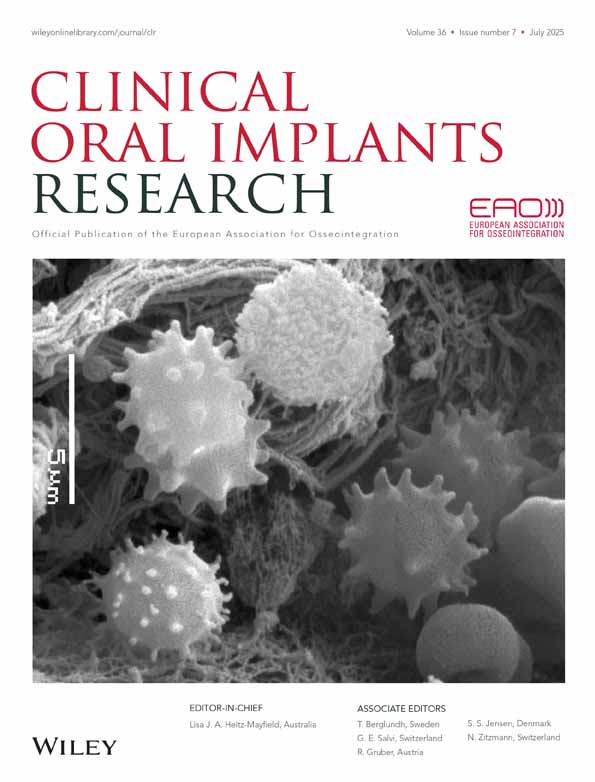Augmentation of the mandible with GTR and onlay cortical bone grafting
An experimental study in the rat
Abstract
enAbstract: The aim of the present study was to evaluate the effect of augmenting the mandible with onlay mandibular bone grafts that were covered with e-PTFE membranes according to the principle of guided tissue regeneration (GTR). The experiment was carried out in 30 rats. The inferior border of the mandible and parts of the mandibular body were exposed on both sides. On one side, an autogenous bone graft that was harvested from the angle of the mandible was placed on the inferior border of the mandible and was fixed with a titanium microimplant. Subsequently, the graft was covered with an e-PTFE membrane. The contralateral side, serving as control, was treated the same way except for the placement of the membrane. Groups of six animals were sacrificed 15, 30, 60, 120 and 180 days following surgery, and specimens that were prepared from the experimental and control sites were analyzed histologically. The bone graft underneath the membrane initially presented superficial resorption but, subsequently, the space that was created by the membrane gradually became filled with bone. After 180 days, the area underneath the membrane was completely filled with bone and it was impossible to distinguish between the bone graft and the newly formed bone. Generally, the bone grafts at the control sides were characterized by a gradual resorption during the entire experimental period. At 180 days after transplantation, only a few grafts at the control sites had retained their height, and there was frequently a lack of continuity between the bone graft and the underlying mandibular bone. It can be concluded that onlay mandibular bone grafts combined with GTR may improve the predictability of mandibular augmentation, in comparison to bone grafting alone.
Résumé
frL'objectif de la présente étude était d'évaluer l'effet de l'augmentation de la mâchoire au moyen de greffes osseuses maxillaires on onlay recouvertes de membranes en e-PTFE selon le principe de la régénération tissulaire guidée (RTG). L'expérience a été effectuée sur 30 rats. La bordure inférieure de la mâchoire et certaines parties due corps maxillaire ont été exposées des deux côtés. D'un côtés. D'un côté, un greffon osseux autogène collectéà partir de l'angle de la mâchoire a été placé sur la bordure inférieure de la mâchoire et fixéà l'aide d'un micro-implant en titanium. Ensuite, la greffe a été recouverte d'une membrane en e-PTFE. Le côté contralatéral, qui servait de contrôle, a été traité de la même façon mais sans placement de membrane. Des groupes de six animaux ont été sacrifiés 15, 30, 60, 120 et 180 jours suivant la chirurgie, et des spécimens préparés à partir des sites expérimentaus et de contrôle ont subi une analyse histologique. La greffe osseuse sous la membrane présentait initialement une résorption superficielle mais par la suite, l'espace créé par la membrane s'est progressivement rempli d'os. Après 180 jours, la zone sous la membrane était complètement remplie d'os et il était impossible de distinguer entre la greffe osseuse et l'os nouvellement formé. D'une manière générale, les greffes osseuses et ls côtés de contrôle se sont caractérisées par une résorption progressive au cours de la période expérimentale dans son ensemble. A 180 jours après transplantation, seules quelques greffe sur les sites de contrôle avaient gardé leur hauteur et il y avait fréquemment un manque de continuité entre la greffe osseuse et l'os maxillaire sous-jacent. On peut conclure que les greffes osseuses maxillaires en onlay associées à une RTG peuvent maéliorer la prévisibilité d'une augmentation de la mâchoire, en comparaison à une greffe osseuse seule.
Zusammenfassung
deEs war das Ziel der vorliegenden Untersuchung, die Augmentation des Unterkiefers mittels mandibulären Onlay-Knochentransplantaten, welche mit e-PTFE Membranen gemäss dem Prinzip der “gesteurten Geweberegeneration”rar la predictibilidad del aumento mandibular comparado con injertos óseos solos.




